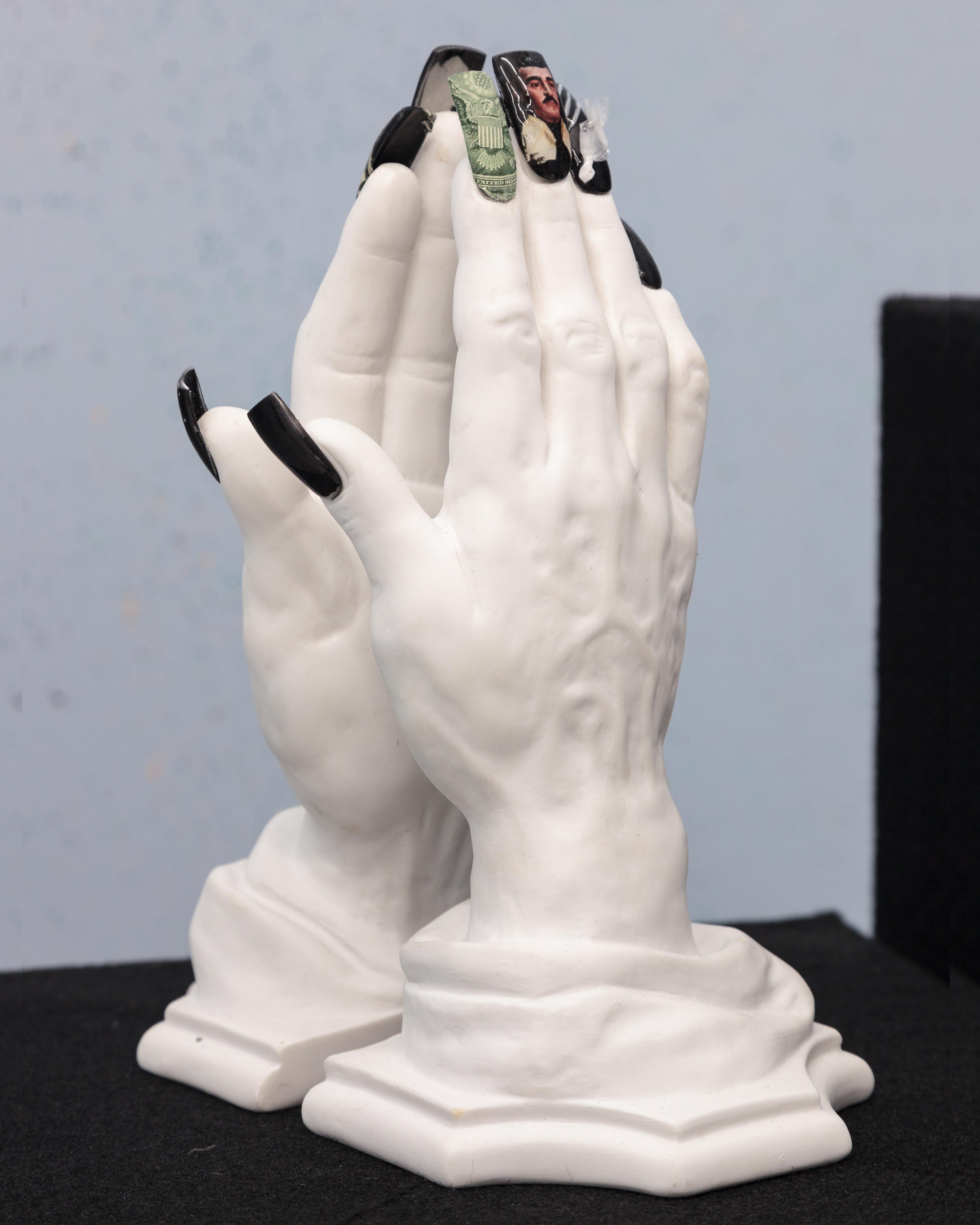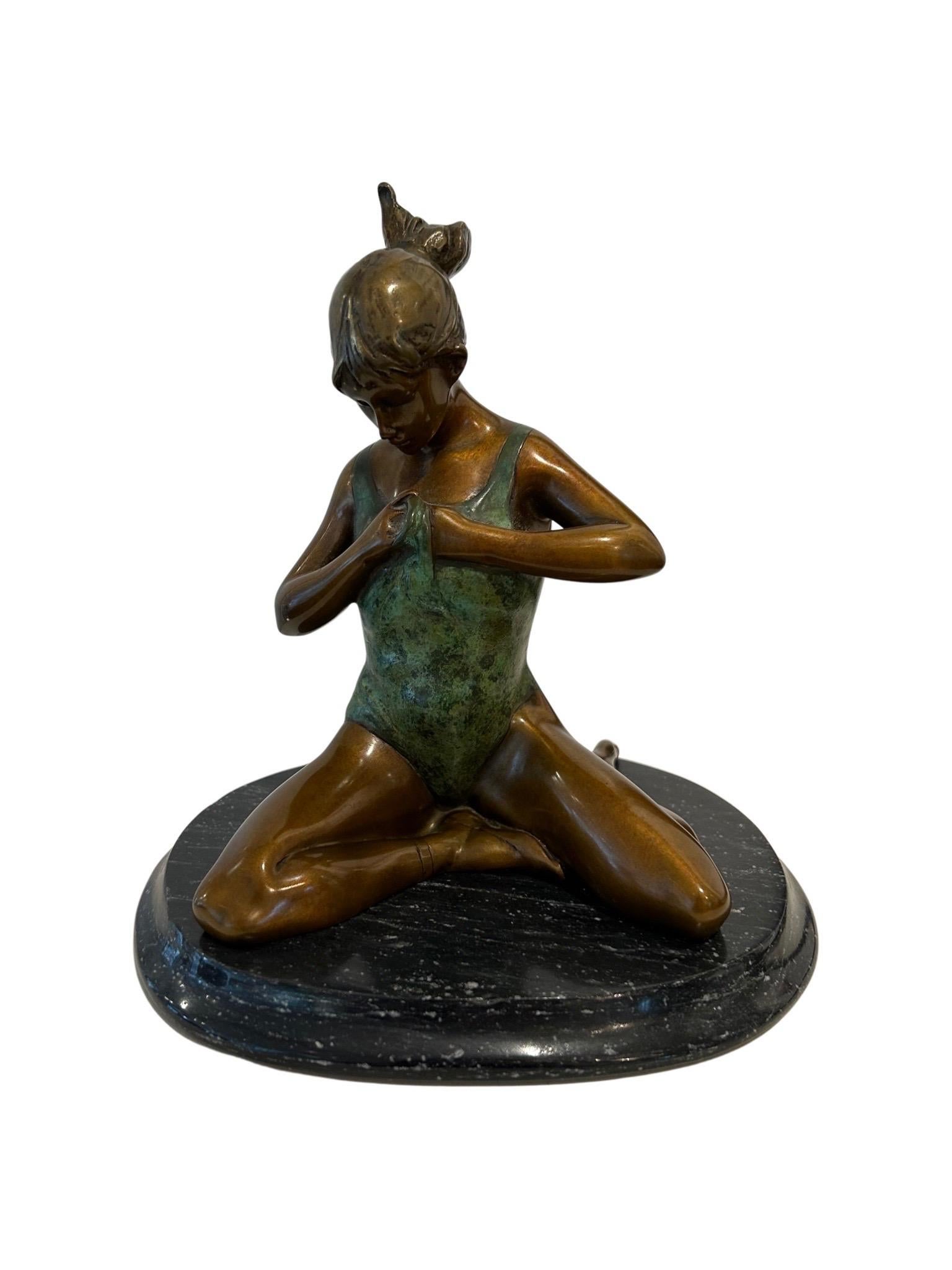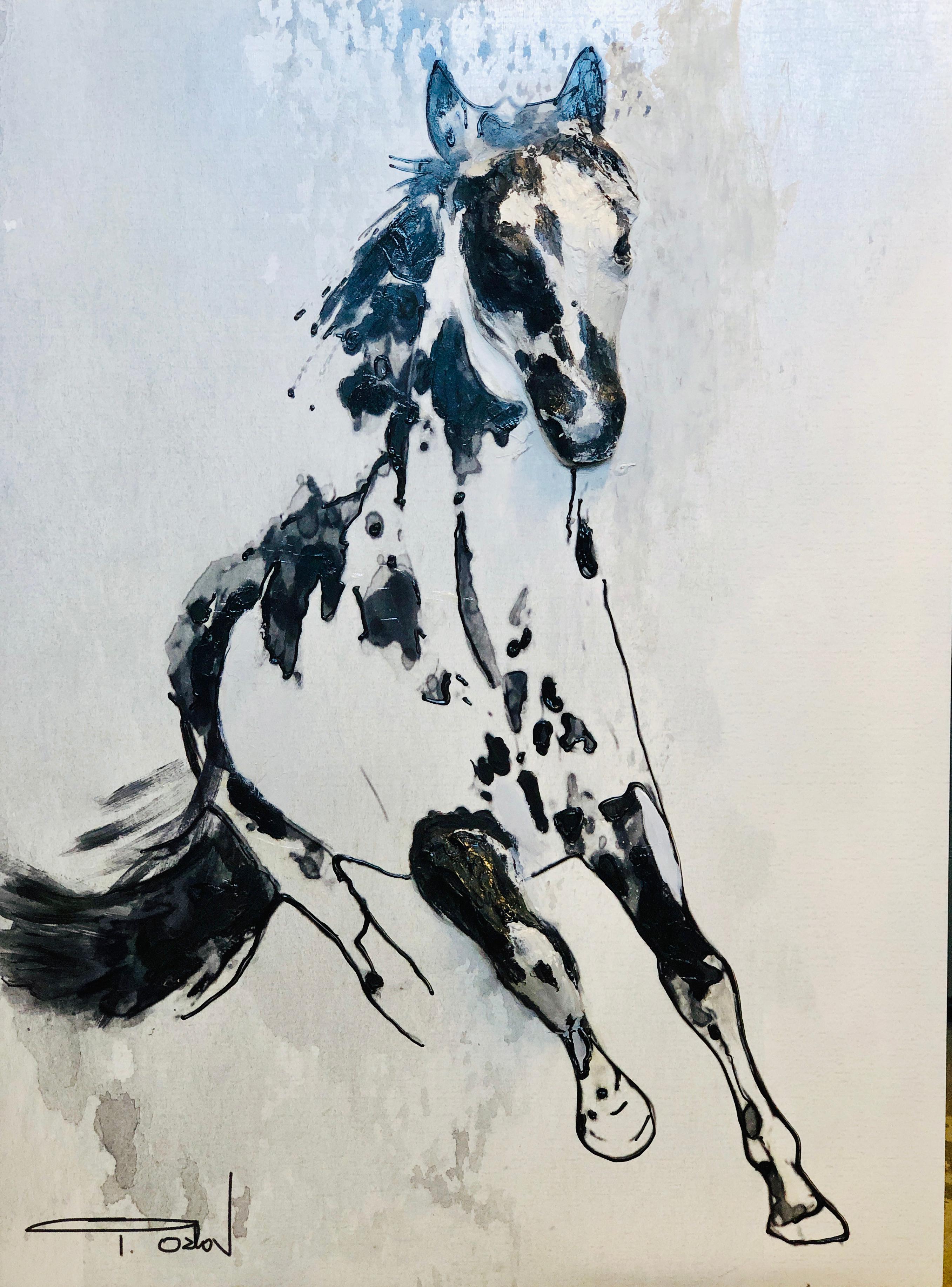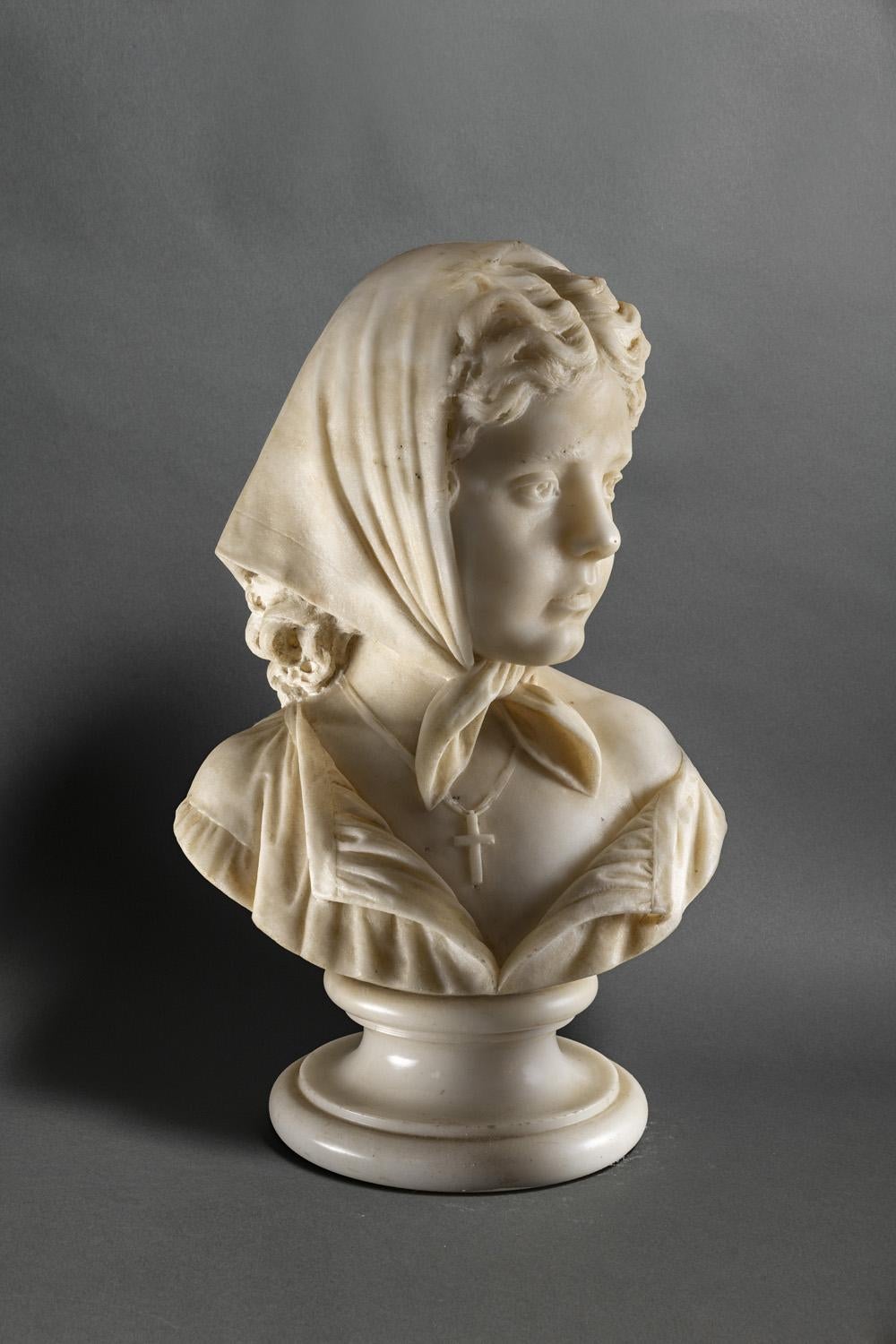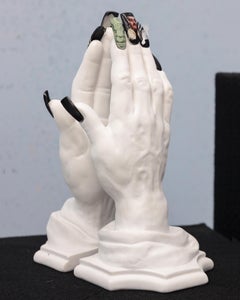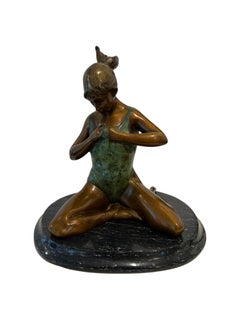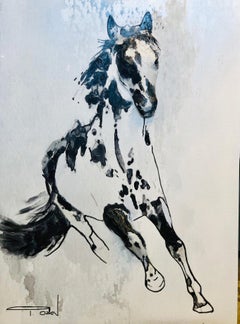Artículos similares a Green Frog
¿Quieres más imágenes o vídeos?
Solicita imágenes o vídeos adicionales al vendedor
1 de 10
Mark MorrisonGreen Frogca. 1940
ca. 1940
Acerca del artículo
Mark Morrison (1895-1964)
Green Frog, ca. 1940
Carved green soapstone
6.5" wide, 5" deep, height is 3.25"
Provenance: Estate of Mrs. Mark Morrison.
Born:
Kingfisher, OK
Education:
University of Missouri
John Flannagan, mentoring and private instruction ca. 1940
Art Students League with William Zorach and Jose de Creeft
Exhibited:
Sculpture Guild Annuals
Audubon Artists Annuals
National Academy of Design Annuals
Pennsylvania Academy Annuals
Metropolitan Museum Artists for Victory, 1942.
Newark Fine Arts Museum
Whitney Annuals
International Exhibition, Fairmount Park, Phila. 1950
Nebraska Fine Arts
Metropolitan Museum Exhibition, 1951
Boston Arts Festival
National Sculpture Society Annuals
Memberships:
Sculpture Guild, Inc.
Audubon Artists
Awards:
Ellen Prince Speyer Award, N.A. 1950
Architects League of New York, Avery Award, 1958, 1959.
Museum Collections:
Metropolitan Museum of Art
National Academy of Design
Pennsylvania Academy of Fine Arts
Whitney Museum of American Art.
Museum of Fine Arts, University of Arizona
Mark Morrison began his life as a sculptor while nearing his professional retirement. In the late 1930s and into the 1940s, he like many of the younger artists in New York City availed himself to the great many academies, museums, teachers and mentors it offered. He studied with John Flannagan before his death, and then Jose de Creeft and Williams Zorach at the Art Students League. Having an attraction and aptitude for the ideas of the direct carving movement and good thorough craft, he took advantage of the growing public interest in a new American sculpture, and worked quickly to become a contemporary of his teachers. Through the 1950s, he exhibited with them, sold, entered competitions, and won awards. He was a sculptor with a sure hand, a head for academy, patience, and promise. Morrison died suddenly in October 1964 having had just married his second wife earlier the same year. Mrs. Mark Morrison would offer a small piece for one more exhibition with a Sculptors Guild in 1965. The work was never seen again until 2025.
Morrison was born on New Year’s Day in 1895 in Kingfisher, Oklahoma, a small rural city not yet a part of the Union. The only child of a Protestant minister, and one of only 16 that in 1913 would graduate from his high school in Higginsville, Missouri. He studied agriculture at the University of Missouri, at some point leaving to enlist in the army. He would reach the rank of Major. After the war, he married his first wife, moved to New York and began work for Tidewater Oil. He worked with them until 1954, retiring as a vice president. At the time he was living at 8 W. 13th St., his studio already set up in a corner of the basement in his apartment building.
The earliest exhibition on record for a work by Morrison was the Artists for Victory show at the Metropolitan Museum, 1942. Earlier the same year, John Flanagan committed suicide. The death was a terrible blow. Flannagan had been a profound influence, sharing both technical instruction and philosophical guidance. The importance of their friendship during the 1930's cannot be overemphasized. Morrison is part of Flannagan's artistic legacy, his only known pupil during the mythical sculptor's short life. Born in the same year of 1895, both artists came to NYC from rural regions of the US: Oklahoma and North Dakota respectively. In contrast to Morrison's stable life, Flannagan was a deeply troubled, difficult, impatient and unpredictable man. To have considered mentoring Morrison, his teacher must have seen a kindred spirit and artist of extraordinary potential. In turn, Morrison must have been a sympathetic and patient pupil who recognized the importance of overlooking personal shortcomings for the invaluable instruction of an artistic genius.
Morrison did not show regularly for almost 10 years spending this time educating himself, exhibiting here and there. He continued his sculpture studies at the Art Student League with Zorach and de Creeft, spending most nights working stones in his studio. His mature style would become clearly realized by 1950, a synthesis of the naïve and the sophisticated, what Flanagan called "the image in the rock", and the polished fluid marbles of Zorach.
Black Swan was featured in the Sculptors Guild exhibition "In Time and Place" at the Museum of Natural History in March 1952. And exhibit pushing those points in their mission to assist the public to fuller appreciation of sculpture, and that the sculpture and the architecture of buildings may again be planned simultaneous and homogeneously. Morrison's swan was the centerpiece of the modern living room designed by Earnshaw, Inc. In the same hall of the museum one year earlier Morrison and other members of the group demonstrated process at work in seven makeshift studios. He would continue to exhibit in Guild annuals and Audubon Artist annuals. His sculpture "Gosling" was given a special honorable mention from the Architects League in the Avery Competition of 1958, runner up to Zorach. In 1959, when he showed "Grasshopper" he won outright.
He had moved his studio to a larger more private space a few blocks away in Greenwich Village. By 1964 his work had become larger in scale, his groupings more challenging and lively, more considerate of light and the nature of the stone itself. He had lost weight and for a man of nearly 70 years old was in very good health. His death was unexpected and unfortunate, probably of a stroke . His legacy has survived, largely unknown until now in a small ranch in upstate New York.
- Creador:Mark Morrison (1895 - 1964, Americana)
- Año de creación:ca. 1940
- Dimensiones:Altura: 10,8 cm (4,25 in)Anchura: 15,24 cm (6 in)Profundidad: 12,7 cm (5 in)
- Medio:
- Movimiento y estilo:
- Época:
- Estado:
- Ubicación de la galería:Wilton Manors, FL
- Número de referencia:1stDibs: LU245216297662
Sobre el vendedor
4,9
Vendedor Platino
Vendedores premium con una calificación de +4,7 y tiempos de respuesta de 24 horas
Establecido en 2007
Vendedor de 1stDibs desde 2015
399 ventas en 1stDibs
Tiempo de respuesta usual: 2 horas
- EnvíoRecuperando presupuesto…Envío desde: Wilton Manors, FL
- Política de devolución
Partes de esta página se han traducido automáticamente. 1stDibs no puede garantizar la exactitud de las traducciones. El inglés es el idioma predeterminado de este sitio web.
Garantía de autenticidad
En el improbable caso de que haya algún problema con la autenticidad de un artículo, ponte en contacto con nosotros en un plazo de 1 año para recibir un reembolso total. DetallesGarantía de devolución de dinero
Si tu artículo no es como se describe, sufre daños durante el transporte o no llega, ponte en contacto con nosotros en un plazo de 7 días para recibir un reembolso total. DetallesCancelación dentro de las 24 horas
Tienes un período de gracia de 24 horas para reconsiderar tu compra, sin preguntas.Vendedores profesionales aprobados
Nuestros vendedores de primera clase deben cumplir estrictos estándares de servicio para mantener la integridad de nuestros anuncios.Garantía de igualación de precios
Si encuentras que un vendedor publicó el mismo artículo por un precio menor en otro lado, igualaremos ese precio.Entrega global de confianza
Nuestra red de transporte de primera ofrece opciones de envío especializado en todo el mundo, que incluye envío personalizado.Más de este vendedor
Ver todoYoung Penguin
Mark Morrison (1895-1964)
Young Penguin, ca. 1950
Carved Tennessee Marble
8.5" x 7" by 3.5", height is 13 inches.
Provenance: Estate of Mrs. Mark Morrison.
Born:
Kingfisher, O...
Categoría
mediados del siglo XX, Realista, Esculturas
Materiales
Mármol
Gato dormilón
Mark Morrison (1895-1964)
Gato dormido, ca. 1940
Granito de Vermont tallado
7,5" de ancho, 5" de profundidad, la altura es de 7
Procedencia: Patrimonio de la Sra. de Mark Morriso...
Categoría
mediados del siglo XX, Realista, Esculturas
Materiales
Granito
Cinnamon Bear
Mark Morrison (1895-1964)
Cinnamon Bear, ca. 1950
Carved red granite
11" wide, 11" deep, height (including wood base) is 15"
Provenance: Estate of Mrs. Mark Morrison.
Born:
...
Categoría
mediados del siglo XX, Realista, Esculturas
Materiales
Granito
Larva
Mark Morrison (1895-1964)
Larva, ca. 1940
Carved brown soapstone
9.5" long, 4" wide, 3.75" tall
Provenance: Estate of Mrs. Mark Morrison.
Born:
Kingfisher, OK
Education:
Un...
Categoría
mediados del siglo XX, Realista, Esculturas
Materiales
Piedra
4000 US$
Chipmunk
Mark Morrison (1895-1964)
Chipmunk, ca. 1940
Italian granite
5" by 4", height is 4 1/8"
Provenance: Estate of Mrs. Mark Morrison.
Born:
Kingfisher, OK
Education:
Universit...
Categoría
mediados del siglo XX, Realista, Esculturas
Materiales
Piedra
2000 US$
Ram
Mark Morrison (1895-1964)
Carnero, hacia 1940
Diorita tallada
9" de largo, 6" de ancho, la altura es de 7,5
La banda oxidada del cuarto trasero es una oclusión natural de mineral...
Categoría
mediados del siglo XX, Realista, Esculturas
Materiales
Granito
5000 US$
También te puede gustar
Uñas postizas Malverde
Una pieza de la serie Nail tips en la que el artista habla de la situación política en EE.UU.
Categoría
2.º década del siglo XXI, Realista, Esculturas figurativas
Materiales
Mármol
Figura de bronce fundido "Bailarina sentada" sobre base de granito
Escultura de bronce de una bailarina descansando. Su leotardo está patinado en un precioso tono verde que contrasta con el color bronce del resto de su figura. En sus pies se ven zap...
Categoría
Siglo XXI y contemporáneo, Realista, Esculturas figurativas
Materiales
Granito, Bronce
500 US$ Precio de venta
Descuento del 50 %
Escultura clásica de bronce fundido de un caballo
Escultura realista de un caballo de pie en bronce sobre una base de mármol negro. La base de bronce está patinada en un tono diferente para imitar el suelo.
Siegfried (Siggy) Puchta...
Categoría
Siglo XXI y contemporáneo, Realista, Esculturas
Materiales
Mármol, Bronce
1650 US$ Precio de venta
Descuento del 25 %
Caballo salvaje corriendo Pintura tridimensional sobre madera 40H X 30" W
Por Irena Orlov
Caballo salvaje corriendo Pintura tridimensional sobre madera 40H X 30" W
2019 en Los Angeles
Obra Colaborativa - Irena Orlov-Zeev Orlov
ESPECIFICACIONES:
Combina Pintura y Escult...
Categoría
2.º década del siglo XXI, Realista, Esculturas figurativas
Materiales
Alabastro
Caballo salvaje corriendo Escultura tridimensional pintada sobre madera 40HX30" A
Por Irena Orlov
Caballo salvaje corriendo Pintura tridimensional sobre madera 40H X 30" W
2019 en Los Angeles
Obra Colaborativa - Irena Orlov-Zeev Orlov
ESPECIFICACIONES:
Combina Pintura y Escult...
Categoría
2.º década del siglo XXI, Realista, Esculturas figurativas
Materiales
Alabastro
7800 US$ Precio de venta
Descuento del 22 %
Scultura in marmo italiana ritratto di fanciulla religiosa del XIX secolo
El busto marmóreo, fechado en 1890, pertenece a su edad adulta, concretamente al último año de su vida, cuando era muy rico y tenía un estudio muy prolífico en Florencia. Representa ...
Categoría
Década de 1890, Realista, Esculturas figurativas
Materiales
Mármol
